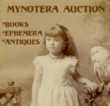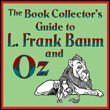|
|
|


<<< Continued from previous page
o GOOD: A copy that has been read, but remains in clean condition. All pages are intact, and the cover is intact - including dust cover, if applicable. The spine may show signs of wear. Pages can include limited notes and highlighting, and the copy can include "From the library of" labels.
(Not only can this grade include the "From the library of" labels, but it's also the proper category for ex-library books [unlike most non-Amazon grading systems, which would grade them significantly lower]. In the comments area you still need to note the presence of call letters, stickers, stamps, pockets, etc., and specify that the book is an ex-library copy. Any ex-library book should not be listed in a higher condition than Good, even if it appears never to have been read.)
o ACCEPTABLE: A readable copy. All pages are intact, and the cover is intact - the dust cover may be missing. Pages can include considerable notes--in pen or highlighter--but the notes cannot obscure the text.
(It's important to note for this condition that the cover must be intact, even if it's the worst possible copy you can legally list on Amazon. Occasionally, you may come across books with the covers ripped off with the following appearing inside: "If you purchased this book without a cover, you should be aware that this book is stolen property." When bookstores return unsold books to publishers for credit, they tear off and return only the covers to show the publisher that the books themselves have been destroyed. If you come across some that have been salvaged, don't buy them or accept them if you plan to sell them.)
[EDITOR'S NOTE: If a book is missing its dust jacket, the highest permissible Amazon grade is Acceptable. Exceptions to this are books that were issued without dust jackets, but do take care to confirm that these books indeed weren't issued with them. It's especially unwise to assume that books published in the early 1900s were never jacketed. Most were.]
o UNACCEPTABLE: Moldy, badly stained, or unclean copies are not acceptable, nor are copies with missing pages or obscured text. Books that are distributed for promotional use only are prohibited. This includes advance reading copies (ARCs) and uncorrected proof copies.
Although not spelled out here, Teacher's or Instructor's Editions of textbooks are not allowed. In the Help section ("Marketplace Seller Offenses & Prohibited Content") you'll see this rule:
o Solutions manuals. Manuals or teacher's editions that provide answer keys to student textbook editions are prohibited.
A rather new addition to these rules are changes to the Collectible category:
Items priced at or above the list price (MSRP) or $10, whichever is greater, are eligible for "Collectible" designation. Items priced below this may be listed under "Used" or "New," but will not be eligible for "Collectible" designation.
These additional guidelines, although not mandatory, may be used to determine whether to list a book as Collectible. To be considered collectible, books should be unique in a way that increases value for a collector, for example:
o First edition and first printing, signed, inscribed or scarce
o Not ex-library, a remainder or a book club edition
Be sure that your books match the catalog pages you list them on exactly. If a matching page doesn't exist, you can create one if you're a Pro Merchant. The Pro Merchant program costs $39 a month, but since the $.99 per-sale fee is waived, if you sell more than 39 items per month, you'll save money.
If you're not a Pro Merchant and the only listing is for, let's say, the hardcover edition and you have the softcover edition, should you list your softcover on the hardcover page and add, "This is a softcover edition"? Amazon says no - it's a violation, and if the buyer receives the wrong edition, they can complain. They can also file an A-z Guarantee Claim as "Materially Different," and they would win. Amazon would then remove the funds from your account and refund the customer, allowing them to keep the book in question.
Comments
-
In addition to choosing a grade, you are encouraged to write something in the comments field. It's your only free text area, the only place you have to communicate what is different, unique, special - or damaged about your particular copy. Mention rips, tears, bends, creases, markings, highlighting, etc. Remember that your buyer is purchasing from you sight unseen. They really don't want to know that you're "A great seller with a wonderful rating and excellent return policy!" That doesn't tell them what may be wrong with your copy of the book. If it smells a little smoky, disclose it. If there is a remainder mark (usually a slash or dot made by a marker on the outer edge of the book) disclose it. Paint an honest picture. Of course, you want to make the sale, but it is not a good idea to glaze over defects and only say glowing, positive things. Your buyer will more than likely be disappointed, if not upset when they're surprised with a damaged book.
I like to start with the cover and go to key areas that I mention in a book description: "Covers lay flat and are shiny, spine is uncreased, text is clean and unmarked." This sort of gives a virtual 360-degree turn of the book. If there is an image provided on the listing by Amazon, I usually state "Exactly as shown."
I sold a book once that appeared to be unread. The spine was uncreased, the text pages were crisp and clean, but inexplicably the front cover was bent back and a clear tire tread went across the title page. How would you list this book for sale? I mulled it over for a bit and then listed it as Good with the comment, "This book was new and unread when it was tragically run over by a car tire. It has survived to tell the tale, but the front cover is bent and creased, and there is a clear tire tread mark on the title page. Spine is uncreased; all text pages are clean and unmarked." The book sold at a discount, and there was no complaint. My buyer knew exactly what to expect.
Here's a description from another seller: "Looks like this book fell out of the ugly tree and hit every branch on the way down." Humor can be good way to get noticed and communicate with your potential buyer, but make sure you also describe exactly what makes the book so ugly. After reading this description, I might expect creases, water damage or worse.
|
|







|
|












|


